Low Voltage vs Line Voltage A Comprehensive Guide for Homeowners

Choosing the right type of voltage for your home can be a daunting task. Whether you're renovating your home or building a new one, understanding the differences between low voltage and line voltage is crucial. This guide aims to break down the distinctions, pros, and cons of each, helping you make an informed decision. If you're looking for electricians in Apopka, FL, contact Spectrum Electric today to schedule an appointment.
What is Low Voltage?
Low voltage systems typically operate at 30 volts or less. Commonly used for landscape lighting, security systems, and home automation, low voltage systems are known for their energy efficiency and safety. Let's explore the primary advantages and disadvantages of using low voltage in your home.
Advantages of Low Voltage
- Safety: Low voltage systems pose less risk of electric shock, making them ideal for outdoor installations and areas where children or pets are present.
- Energy Efficiency: Low voltage systems consume less power, which can lead to lower electricity bills.
- Flexibility: These systems are easier to install and modify, making them perfect for DIY enthusiasts.
Disadvantages of Low Voltage
- Limited Power: Low voltage systems are not suitable for high-power appliances and devices.
- Initial Cost: The upfront cost for low voltage systems can be higher due to the need for transformers and specialized fixtures.
What is Line Voltage?
Line voltage, also known as standard voltage, operates at 120 volts in residential settings in the United States. This is the most common type of voltage used in homes and is suitable for most household appliances and lighting.
Advantages of Line Voltage
- Powerful: Line voltage systems can handle high-power appliances and provide robust performance for various applications.
- Accessibility: Since line voltage is the standard in the U.S., finding compatible fixtures and appliances is easier and more cost-effective.
- Durability: Line voltage systems often have a longer lifespan compared to their low voltage counterparts.
Disadvantages of Line Voltage
- Safety Concerns: Higher voltage means a higher risk of electric shock, making it less safe for certain applications, especially outdoor use.
- Energy Consumption: Line voltage systems consume more power, which can lead to higher electricity bills.
Applications of Low Voltage and Line Voltage
Understanding where to use low voltage and line voltage systems can help you optimize your home's efficiency and safety. Below are common applications for each type of voltage.
Common Applications of Low Voltage
- Landscape Lighting: Ideal for garden and pathway lighting, low voltage systems provide enough illumination without posing safety risks.
- Security Systems: Most modern security systems operate on low voltage, ensuring they are both effective and safe.
- Home Automation: Smart home devices, such as thermostats and lighting controls, often use low voltage for operation.
Common Applications of Line Voltage
- Indoor Lighting: Line voltage is suitable for most indoor lighting fixtures, including ceiling lights, chandeliers, and wall sconces.
- Kitchen Appliances: Major kitchen appliances like ovens, refrigerators, and dishwashers require line voltage to function efficiently.
- HVAC Systems: Heating, ventilation, and air conditioning systems typically operate on line voltage due to their high power requirements.
Making the Right Choice for Your Home
Choosing between low voltage and line voltage depends on various factors, including the specific applications, safety requirements, and energy consumption concerns. Here's a quick guide to help you decide:
Factors to Consider
- Safety Needs: If safety is a primary concern, especially in outdoor areas or homes with children, low voltage systems are the better choice.
- Power Requirements: For high-power appliances and general household needs, line voltage is more suitable.
- Energy Efficiency: If reducing energy consumption is a priority, low voltage systems can help achieve that goal.
- Budget: Consider both the initial installation cost and long-term electricity bills when making your decision.
Conclusion
Understanding the differences between low voltage and line voltage can significantly impact the safety, efficiency, and functionality of your home. Both types of voltage have their unique advantages and applications. If you're still unsure about which type of voltage system is right for your home, consulting with a professional electrician can provide further insights.
For homeowners in Apopka, FL, Spectrum Electric offers expert advice and services to help you make the best choice for your electrical needs. Our team of experienced electricians is here to ensure your home is both safe and efficient.
Call to Action
If you're looking for electricians in Apopka, FL, contact Spectrum Electric today to schedule an appointment. Our team is ready to assist you with all your electrical needs, ensuring your home is both safe and efficient.
